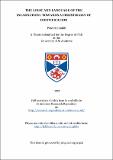Files in this item
The logic and language of the incarnation : towards a Christology of identification
Item metadata
| dc.contributor.advisor | Shaw, D. W. D. | |
| dc.contributor.author | McEnhill, Peter | |
| dc.coverage.spatial | 415 p. | en_US |
| dc.date.accessioned | 2018-06-11T11:11:12Z | |
| dc.date.available | 2018-06-11T11:11:12Z | |
| dc.date.issued | 1993-07 | |
| dc.identifier.uri | https://hdl.handle.net/10023/13889 | |
| dc.description.abstract | This thesis provides an examination of the contemporary discussion of incarnational language as its receives classical expression in the formulations of the Council of Chalcedon in 451 A.D. with a view to developing an incarnational account based on God's identification with Jesus of Nazareth. With this in view consideration is given to a number of contemporary defences of the logic of Chalcedon viewed as a literal statement of identity. It is argued that such defences fail in that they carry over the tensions inherent in Chalcedon unresolved into their own positions. From this conclusion consideration is given to the criticism that incarnational language is not literal but metaphorical. This is agreed, but an argument is offered to show that metaphors can refer and bear cognitive information and as such are capable of conceptual articulation. It is further argued that there is an important class of metaphors which are 'theory-constitutive' such that the theoretical claims which they embody cannot be expressed apart from the metaphor. An attempt is made to show that the metaphor of incarnation is one such 'theory-constitutive' metaphor. The results of this general discussion of incarnational language are then applied to the christological theories of Theodore of Mopsuestia and Donald Baillie. It is argued that they are legitimate and proper attempts to articulate the claims embodied in the metaphor of incarnation. An attempt is made to show that they offer a genuine middle way between Chalcedon and purely inspirational accounts of the incarnation. However, it is conceded that the traditional question raised against these theories, as to whether or not they can successfully maintain a unity of person, is a legitimate one, given their failure to indicate adequately how the union operated. The concept of God's identification with Jesus of Nazareth is introduced as one which shares a certain 'family resemblance' to Baillie's and Theodore's approach. It is argued that the concept of identification provides the type of conceptual underpinning that both Baillie's and Theodore's approach require. The fourth and fifth chapters of this thesis are devoted to presenting an account of the incarnation from the perspective of identification with particular emphasis being given to demonstrating that the concept of identification can account for the unity of God and man in Christ whilst respecting the integrity and individuality of the human person. | en_US |
| dc.subject.lcc | BT220.M3 | en |
| dc.subject.lcsh | Incarnation--History of doctrines | en |
| dc.title | The logic and language of the incarnation : towards a Christology of identification |
This item appears in the following Collection(s)
Items in the St Andrews Research Repository are protected by copyright, with all rights reserved, unless otherwise indicated.

